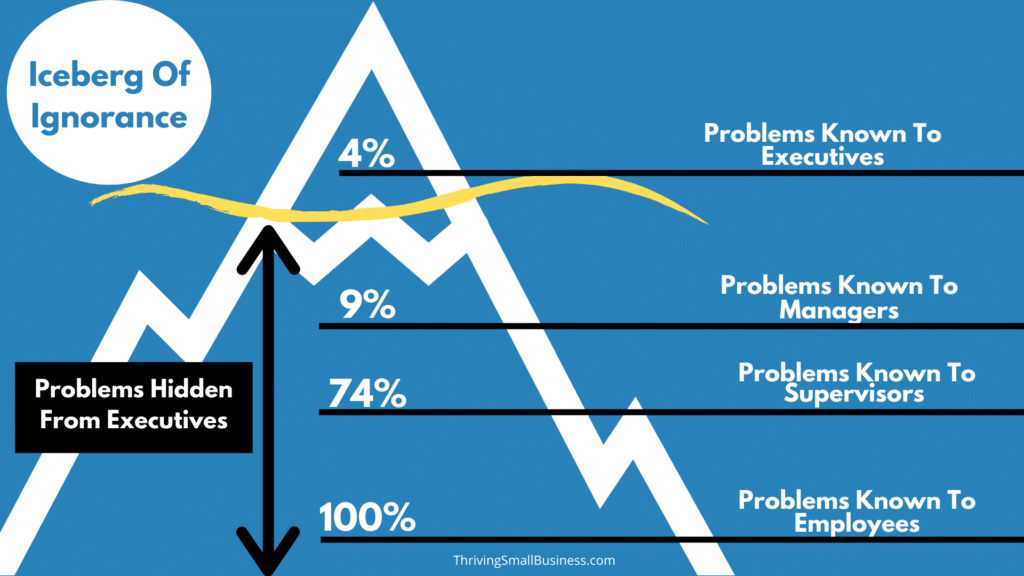Internal Problems Can Impact Your Customers
Estimated reading time: 4 minutes
Any of us who ever had a boss is not surprised to learn that most are clueless about the issues that front-line employees have to contend with.
A friend was telling me about some internal problems her organization has been experiencing.
The difficulty stemmed from well-meaning executives who didn’t understand the day-to-day issues that employees dealt with.
She shared with me that there was a major disconnect between upper management and the front-line employees responsible for taking care of the customers.
The conversation reminded me of a study done in 1989 by Sidney Yshido called The Iceberg of Ignorance.
The research suggested that senior-level management is often so far removed from the day-to-day business operations, that they fail to understand the systems and processes that affect both employees and customers.
The most alarming result of this study suggests that this Iceberg of Ignorance can impact company profits by as much as 40%!

The study concluded that executive-level managers were only aware of 4% of day-to-day problems.
Department managers were only aware of 9% of problems.
Employee supervisors knew of 74% of problems.
However, the front-line employees were aware of 100% of the problems that affected the quality of products or services that were being delivered to customers.
So what makes senior leaders so clueless?
Business leaders are responsible for recognizing and solving workplace problems.
Executive-level leadership needs to be aware of the issues employees face that affect their ability to meet customer needs.
Unfortunately, many executives aren’t aware of organizational problems leaving them ill-equipped to help resolve critical issues that employees have to deal with.
The most troubling aspect of these study findings is that the very people who have the responsibility and ability to solve problems, seem to be the ones who don’t even know the problems exist for the employees who are responsible for serving the customer.
Create a structured process to collect and analyze performance data, which will impact management practices that affect the customer experience.
Whether it is outdated computer software, faulty equipment, or broken processes – executive leadership should be aware, so they can help facilitate positive change for employees, and ultimately, customers.
4 Ways to Better Understand Issues That Affect The Customer
1. Engage Employees In Conversation
There is much that can be learned from simple conversations.
Create a structured process for interacting with employees.
When senior leaders interact with employees, issues are brought to light, employees feel valued, and there is a better understanding of what workers deal with on a day-to-day basis.
I experienced a great model for this at a former employer.
Employees were invited to have lunch with the president of the organization on their milestone employment anniversary date.
Senior executives hosted a monthly lunch, and employees were encouraged to share thoughts, ideas, and job challenges.
This model worked well, was an encouragement to staff, and often resulted in quick problem resolution.
It is incredible how quickly process bottlenecks can be eliminated when a directive comes from top-level leaders.
2. Collect And Study Data
The use of data is critical to managing any type of organization effectively.
Identifying the Critical Success Factors that determine organizational success is one way to collect and study pertinent data that gauges organizational performance.

For instance, if customer satisfaction is a CSF for your organization, collect data regularly, and learn from customer feedback.
Executives should understand and know how to interpret this data to understand common business problems and use their influence to affect positive change.
3. Walk Around And Mingle With Employees
Employees enjoy interacting with senior leaders and are eager to share information about work processes.
It is always fascinating to see what can be learned by interacting with front-line employees.
This hands-on approach sends a message to employees that leadership cares about what happens on the front line.
Walking around allows managers to observe employee behaviors, how they respond to customers, and issues that they may not be aware of.
This practice is also a great way to improve employee engagement.
4. Experience The Product Or Service
Managers should be familiar with all products and services and take the time to experience what the customer experiences.
So whether it is observing the printing press and checking the quality of a finished print job or sampling the food in a restaurant, senior-level managers should know what the customer experiences to help facilitate improvement opportunities.
Today’s economic climate and increasing competition, demand quality products and services.
Leaders at all levels of an organization need to be aware of issues that affect the customer experience and are responsible for getting involved in resolving issues so they can help influence positive change.
Customers rarely have the patience to wait for improvements to be made.
Senior leaders need to break the Iceberg of Ignorance or suffer its inevitable impact on the bottom line.
Are you aware of all the issues affecting your organization?






